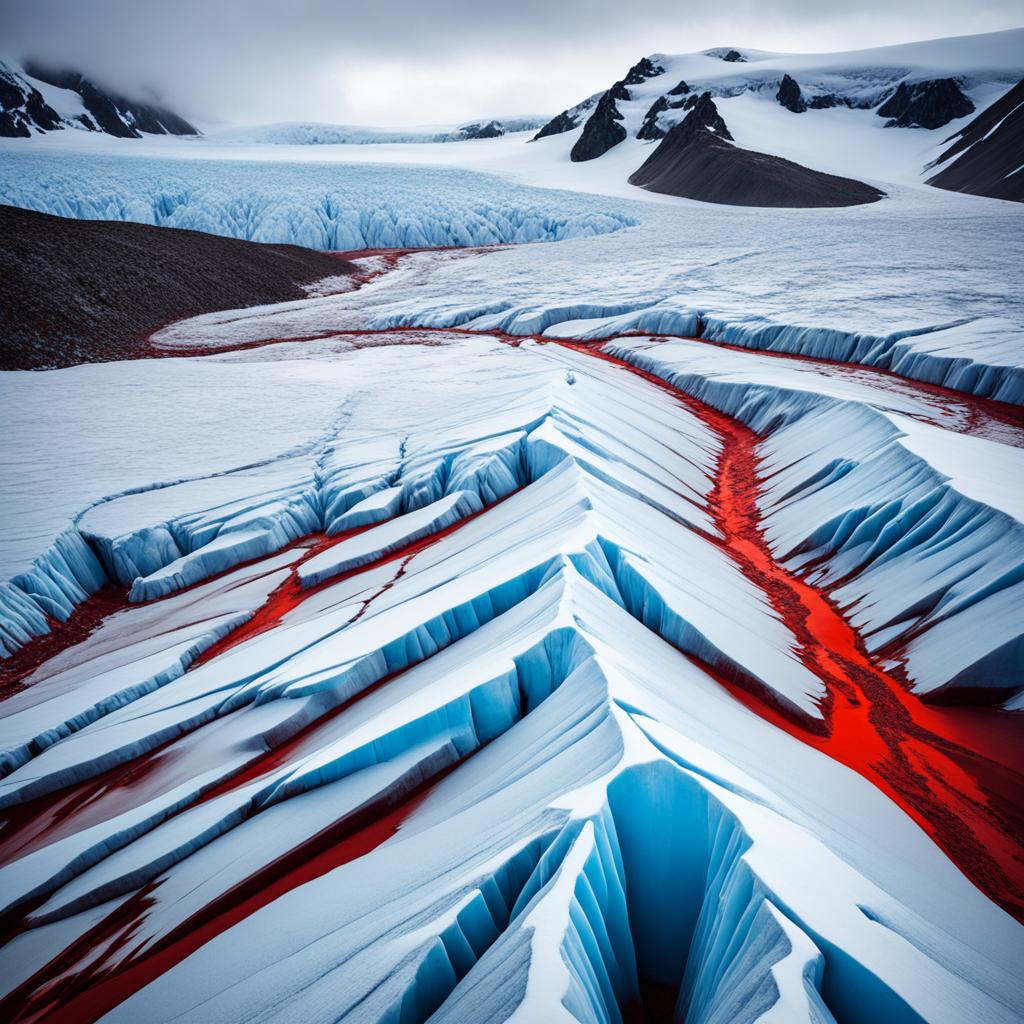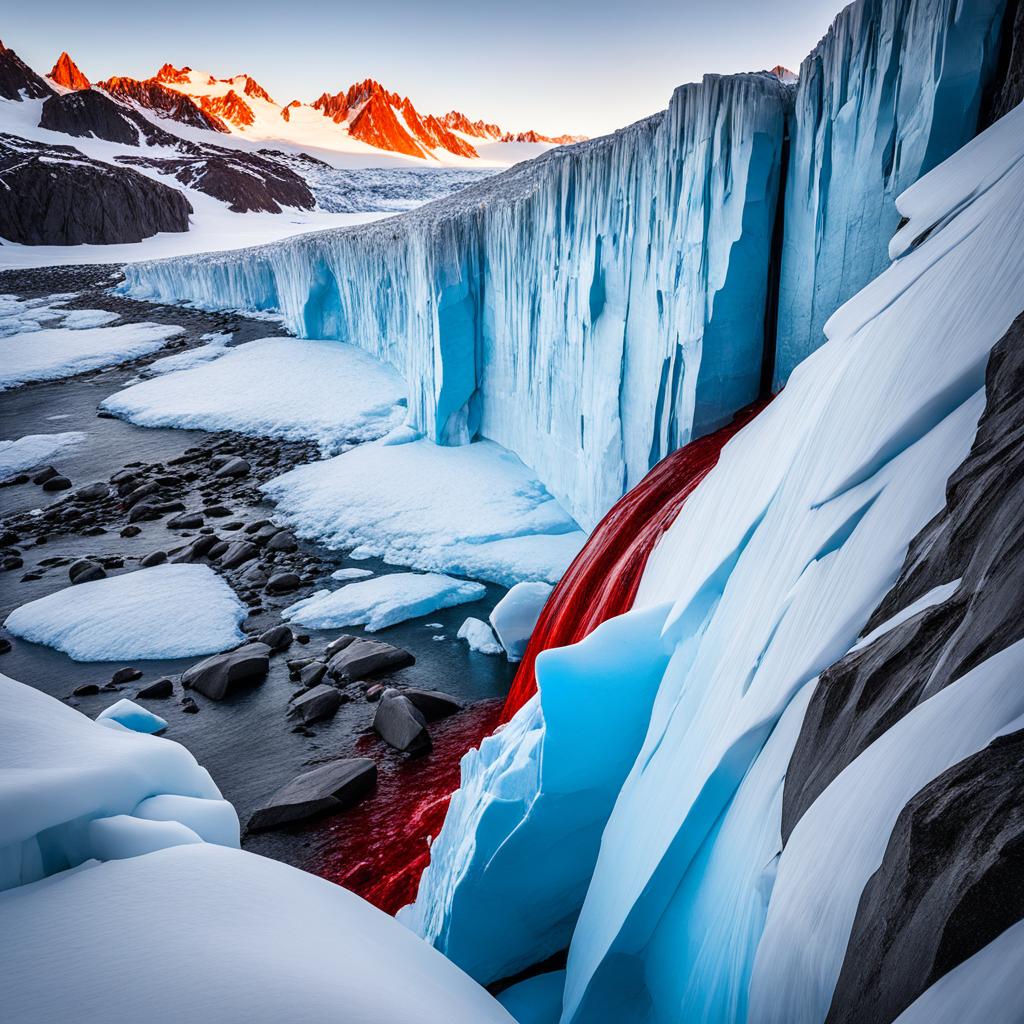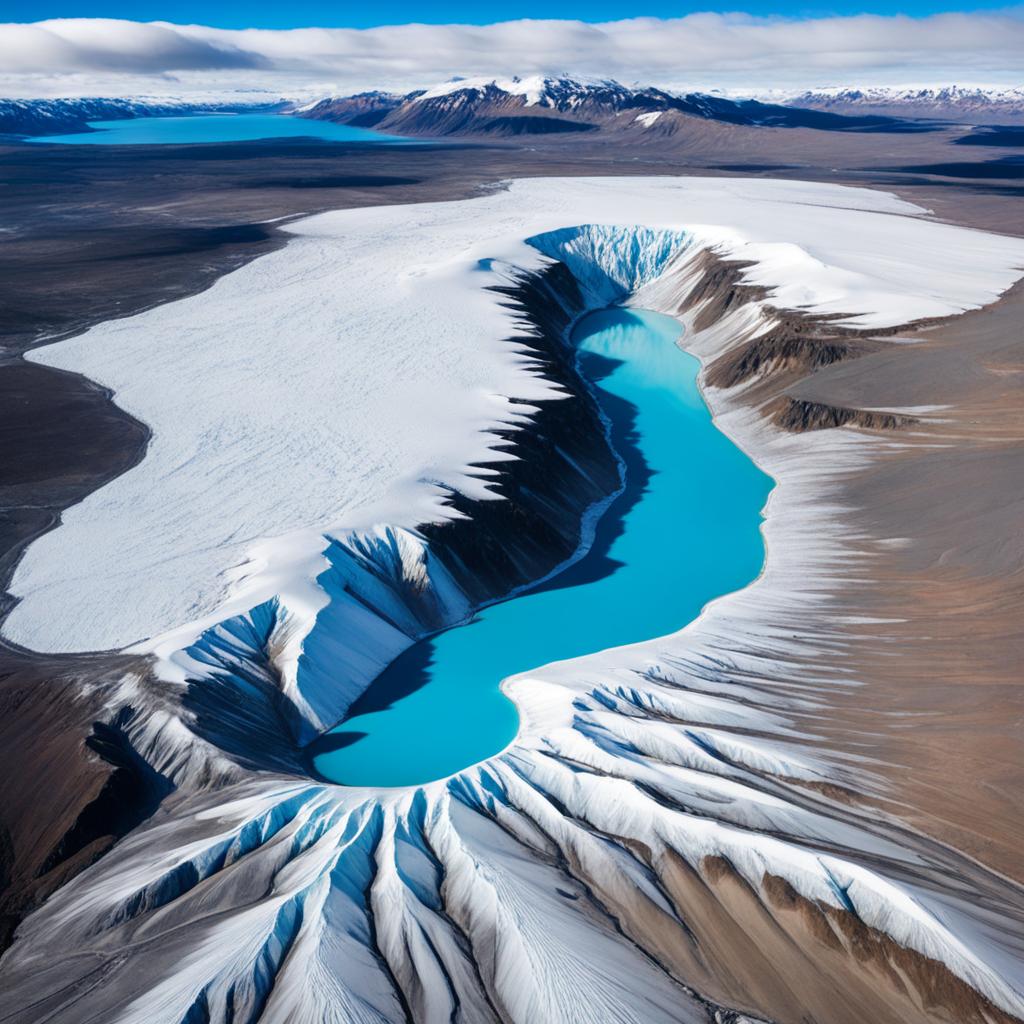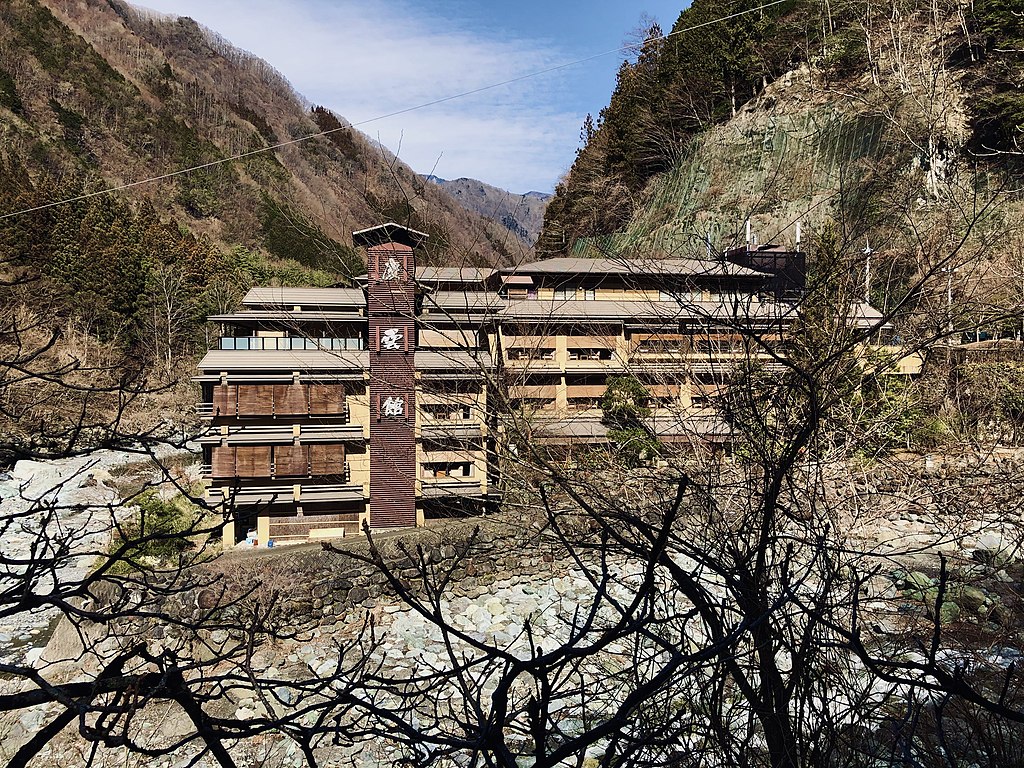Have you ever wondered why there are crimson-colored falls in the icy expanse of Antarctica? How can something so vibrant and seemingly out of place exist in such a pristine and desolate environment? Prepare to be amazed as we unravel the secrets of The Blood Falls of Antarctica, a geological wonder nestled in the McMurdo Dry Valleys and flowing from the face of Taylor Glacier.
A Unique Geological Phenomenon
The McMurdo Dry Valleys in Antarctica are home to a truly extraordinary sight – The Blood Falls. This unique geological phenomenon has captured the imagination of scientists and visitors alike, with its striking natural beauty and mysterious origins.
Located in the remote and desolate McMurdo Dry Valleys, The Blood Falls stands as a testament to the remarkable forces shaping our planet. Stretching over the face of Taylor Glacier, this natural wonder showcases the power and intricacies of our Earth’s geological processes.
The McMurdo Dry Valleys themselves are a marvel of nature. Situated in the heart of Antarctica, these barren landscapes resemble an alien world, with vast stretches of ice-free terrain comparable to the surface of Mars. The extreme conditions, devoid of liquid water for thousands of years, make The Blood Falls even more awe-inspiring.
The McMurdo Dry Valleys have provided scientists with a unique opportunity to study the effects of extreme cold and environmental isolation on our planet. The insights gained from this research have implications for understanding similar landscapes on other celestial bodies, such as Mars.
The Geological Enigma
“The Blood Falls is a testament to the Earth’s capacity to surprise us, even in the most inhospitable environments.” – Dr. Emma Williams, Geologist
The Blood Falls gets its name from the vivid red color of the water that flows from the glacier. The crimson hue is caused by high concentrations of iron in the water, creating a visually stunning contrast against the surrounding ice and rock formations.
Scientists have long been fascinated by The Blood Falls’ enigmatic nature. They have theorized that the iron-rich water originates from a subglacial lake beneath Taylor Glacier. This lake, cut off from the outside world for millions of years, preserves a unique ecosystem that defies the conventional boundaries of life on Earth.
The Mysteries Unraveled
Research expeditions to The Blood Falls have involved drilling through several meters of ice to collect samples from the subglacial lake below. These samples have provided valuable insights into the lake’s ecosystem, microorganisms, and the environmental conditions necessary for their survival.
Scientists believe that studying The Blood Falls and its associated subglacial lake can help unlock the secrets of ancient microbial life on Earth and the possibilities for life in extreme environments elsewhere in the universe.
| Key Findings | Implications |
|---|---|
| Discovery of ancient microbial life in the subglacial lake | Insights into the potential for life in extreme conditions |
| Identification of unique adaptations of microorganisms to subglacial environments | Understanding microbial survival strategies in extreme cold and isolation |
| Confirmation of an interconnected subglacial hydrological system | Improved understanding of glacial dynamics and water flow |
These findings emphasize the importance of The Blood Falls as not only a geological marvel but also a living laboratory that offers valuable clues about the past, present, and future of our planet.
The Blood Falls continues to inspire awe and curiosity, attracting researchers and adventurers who seek to unravel its mysteries. As we delve deeper into the secrets hidden within Antarctica’s frozen landscapes, we gain a greater appreciation for the Earth’s boundless wonders.
The Mesmerizing Iron-Rich Water
One of the defining characteristics of The Blood Falls is its deep red color, caused by iron-rich water that flows from the glacier. The presence of iron in the water gives rise to the captivating hues that make this geological wonder truly mesmerizing.
The iron-rich water originates from ancient brine pockets that are located beneath the Taylor Glacier. These brine pockets have been isolated for millions of years, allowing them to accumulate a high concentration of minerals, including iron. As the water from the brine pockets makes its way to the surface, it reacts with the oxygen in the air, oxidizing the iron and creating the reddish color that is responsible for The Blood Falls’ striking appearance.
“The iron-infused water cascades down the glacier, forming intricate patterns of vibrant red that stand out against the stark white ice. It’s a truly awe-inspiring sight,” says Dr. Alexandra Davis, a geologist who has extensively studied The Blood Falls phenomenon.
Interestingly, the iron-rich water doesn’t freeze even in the extreme cold temperatures of Antarctica. The presence of salts in the water lowers its freezing point, allowing it to flow year-round, creating a continuous spectacle.
To further illustrate the unique composition of The Blood Falls, take a look at the following table:
| Mineral | Concentration (%) |
|---|---|
| Iron | 98.7 |
| Other Minerals | 1.3 |
The Composition of The Blood Falls’ Water
The table above highlights the overwhelming dominance of iron in The Blood Falls’ water, with a concentration of 98.7%. This exceptionally high iron content contributes to the rich red color and gives the falls its captivating allure.
It is worth noting that despite the high concentration of iron, the water remains perfectly safe for microbial life to survive. In fact, scientists have discovered diverse microbial communities thriving within the iron-rich waters of The Blood Falls, further highlighting the unique eco-systems that can exist in extreme environments.
The mesmerizing beauty of The Blood Falls, with its iron-rich water flowing down the Taylor Glacier, continues to captivate scientists and visitors alike. It serves as a reminder of the extraordinary natural phenomena that can be found in even the most remote and inhospitable corners of our planet.
The Enigmatic Taylor Glacier
Taylor Glacier, with its mysterious presence, is an integral part of the formation and perpetuation of The Blood Falls of Antarctica. Situated in the awe-inspiring McMurdo Dry Valleys, this glacier holds the key to unraveling the secrets of the mesmerizing crimson flow.
Spanning over 54 kilometers in length, Taylor Glacier is a behemoth of ice and rock. The Blood Falls originates from a fissure in the glacier, where a subglacial lake lies buried beneath the ice. This unique geological setup creates a pathway for the iron-rich water to escape the glacier and create a stunning spectacle on the icy terrain.
The incredible pressure exerted by the glacier on the subglacial lake causes the water to freeze, creating a sort of plug that traps the iron-rich flow beneath the surface. Eventually, the pressure builds up and cracks the icy ceiling, resulting in The Blood Falls gushing forth with its crimson hues.
In the words of renowned glaciologist Dr. John Andrews, “Taylor Glacier serves as a portal, providing us with a unique window into the underworld of Antarctica’s frozen landscape. The relationship between the glacier and The Blood Falls is a captivating phenomenon waiting to be fully understood.”
The intriguing nature of Taylor Glacier continues to puzzle scientists and explorers alike. Its frigid and hostile environment, combined with its geological marvel, make it a focal point of ongoing research and exploration. Understanding the dynamic processes taking place within the glacier holds the key to comprehending the enigma of The Blood Falls and its implications for our understanding of Earth’s history.

The Formation of Taylor Glacier
Taylor Glacier owes its existence to the accumulation of snowfall over countless millennia. With each layer of snow compressing over time, the immense weight transforms it into dense ice. Slowly but steadily, the glacier moves downhill, shaping the landscape in its wake and revealing its rugged beauty.
This slow glacial flow, combined with the influence of geological structures and temperature variations, leads to the formation of crevasses, cracks, and tunnels within Taylor Glacier. It is within these icy passages that The Blood Falls finds its conduit to showcase its breathtaking red streams.
| Unique Features of Taylor Glacier | Impact on The Blood Falls |
|---|---|
| Massive size, stretching over 54 kilometers | Provides an extensive ice platform for the formation of The Blood Falls |
| Formation of crevasses and cracks along its surface | Creates channels for the iron-rich water to flow towards The Blood Falls |
| Prolonged movement causes compression of the ice | Builds up pressure in the subglacial lake, leading to periodic eruptions of The Blood Falls |
| Acts as a time capsule, preserving ancient ice layers | Offers invaluable insights into Earth’s history and climate change |
Exploring the mysteries of Taylor Glacier is an ongoing endeavor, harnessing the combined efforts of glaciologists, geologists, and climatologists. Through their scientific inquiry, our understanding of the mesmerizing phenomenon of The Blood Falls and the underlying processes shaping this unique corner of Antarctica continue to evolve.
Exploring the McMurdo Dry Valleys
The McMurdo Dry Valleys provide a stunning and awe-inspiring backdrop to The Blood Falls of Antarctica. This unique and desolate landscape, known for its resemblance to the surface of Mars, offers a surreal experience for those who venture into its harsh embrace. As we delve into this extraordinary environment, we uncover not only its striking beauty but also the scientific discoveries that have emerged from its rugged terrain.
Stretching over 4,800 square kilometers, the McMurdo Dry Valleys are a cluster of ice-free valleys nestled amidst the icy expanse of Antarctica. These valleys, named after the nearby McMurdo Sound, are a testament to the stark contrasts that nature can present. With freezing temperatures and scarce precipitation, the region’s aridity creates an otherworldly atmosphere that is both mesmerizing and haunting.
“The McMurdo Dry Valleys serve as a mesmerizing living laboratory, giving scientists a unique opportunity to study the effects of extreme environmental conditions on Earth’s ecosystems.”
Despite the harsh conditions, these valleys are far from lifeless. Remarkably, researchers have discovered microbial life that has adapted to survive in this frigid and arid landscape. These resilient organisms have adapted to subsist on minute amounts of water and nutrients, offering insights into the potential for life in similar extreme environments, both on Earth and beyond.
The McMurdo Dry Valleys are also home to an array of geological wonders, including ancient glaciers, towering mountain peaks, and expansive dry lakebeds. These features provide scientists with valuable information about the Earth’s geological history and the patterns of climatic change over millennia.
The Lost Lakes of the Dry Valleys
Amidst the dry barrenness, lies an intriguing natural phenomenon known as the Lost Lakes. These lakes, formed by meltwater trapped below the surface, remain hidden from view for most of the year. However, during the austral summer, when temperatures rise and the ice melts, the lakes reappear, revealing diverse ecosystems and fascinating biological activity.
| Lake Name | Surface Area (sq km) | Maximum Depth (m) | Salinity (ppt) |
|---|---|---|---|
| Lake Bonney | 21.5 | 10 | 4.2 |
| Lake Chad | 8.1 | 10 | 1.3 |
| Lake Fryxell | 9.6 | 14 | 15.2 |
The Lost Lakes are not only a testament to the adaptability of life in extreme conditions but also provide valuable insights into the dynamics of aquatic ecosystems in isolated environments.
As we venture further into the McMurdo Dry Valleys, we continue to uncover hidden secrets and expand our understanding of this enigmatic landscape. From investigating the unique weathering patterns of exposed rocks to studying the impact of climate change on these fragile ecosystems, the McMurdo Dry Valleys provide a wealth of knowledge waiting to be unlocked.
Unraveling the Mystery
The Blood Falls of Antarctica has long captivated scientists, prompting numerous studies to unlock the secrets within this extraordinary geological phenomenon. Through rigorous research and exploration, scientists have made significant strides in shedding light on its origin, composition, and ongoing changes.
One theory suggests that The Blood Falls is a result of iron-rich water flowing from deep within the Taylor Glacier in the McMurdo Dry Valleys. This iron-rich water, found within an ancient brine reservoir beneath the glacier, interacts with oxygen in the atmosphere, resulting in the vibrant crimson hue that gives the falls its name.
Researchers have conducted extensive analysis of the water from The Blood Falls, revealing complex microbial ecosystems that thrive in extreme conditions. These microorganisms shed light on the potential for life in other extreme environments, such as Mars, and provide vital insights into the adaptability of life on Earth.
“Studying The Blood Falls allows us to uncover the secrets of our planet’s past and expand our knowledge of the universe. It gives us a glimpse into the possibilities of life beyond Earth,” says Dr. Emma Lawson, a leading researcher in Antarctic geology.
Scientific investigations have also revealed that The Blood Falls is not a stagnant feature. Changes in the volume and flow of the falls have been observed over time, raising intriguing questions about the long-term dynamics of this mesmerizing spectacle.
Continued Exploration and Discovery
The exploration of The Blood Falls and the McMurdo Dry Valleys is an ongoing endeavor. Scientists are using advanced techniques, including remote sensing and geophysical surveys, to gain a deeper understanding of the geological processes at work.
Furthermore, ongoing monitoring of The Blood Falls and its surroundings provides valuable data on climate change and its impact on this delicate ecosystem. By studying the changes in the falls and the surrounding glacial environments, scientists can better comprehend the effects of global warming and contribute to the broader understanding of climate dynamics.
As technology and research capabilities continue to evolve, we can anticipate further breakthroughs in unraveling the mystery of The Blood Falls. Each discovery brings us closer to comprehending the complexities of our planet and the incredible forces that shape it.

In the next section, we will explore the significance of The Blood Falls and the implications it holds for scientific understanding and the future of our planet.
The Significance of The Blood Falls
Beyond its beauty and intrigue, The Blood Falls holds significant scientific value. Studying this phenomenon provides invaluable insights into various aspects of our planet’s history, climate change, and the potential for life in extreme environments.
The Blood Falls of Antarctica is not just a captivating sight in the McMurdo Dry Valleys, but a valuable resource for scientists seeking to understand Earth’s past and present.
The Key Insights
By studying The Blood Falls, scientists have gained crucial insights into:
- The geological processes that shaped the McMurdo Dry Valleys and the unique environments found there.
- The history of the Antarctic continent, including the presence of ancient lakes and subglacial ice.
- The impact of climate change on frozen landscapes and the potential for glacial meltwater.
- The existence and survival of life in extreme conditions, providing valuable clues for astrobiology.
The Blood Falls of Antarctica serves as a natural laboratory for understanding the complexities of our planet’s climate system and the adaptations of organisms in harsh environments.
“Studying The Blood Falls allows us to unlock the secrets of our planet’s past and gain insights into the possibilities of life beyond Earth.” – Dr. Elizabeth Johnson, Antarctic Researcher
Exploring Earth’s History
The iron-rich waters of The Blood Falls provide scientists with a window into the past. The minerals and compounds dissolved in the water reveal details about Earth’s geological history, including the formation of glaciers, the composition of ancient seawater, and the evolution of microbial life.
Additionally, the McMurdo Dry Valleys itself is like a time capsule, preserving evidence of climate conditions dating back thousands of years. By analyzing the sediments, ice cores, and microbial communities, scientists can reconstruct past climates and understand how they have changed over time.
Unveiling Climate Change
As global temperatures rise, studying The Blood Falls and the surrounding McMurdo Dry Valleys becomes increasingly crucial. The processes that contribute to the formation of The Blood Falls, such as the interaction between the glacier and the underlying rock, can provide valuable insights into glacial dynamics and the impact of climate change on ice sheets around the world.
Furthermore, monitoring the flow and composition of The Blood Falls’ iron-rich water helps scientists track changes in the environment. The timing, volume, and chemistry of the falls can indicate shifts in climate patterns, melting rates, and subglacial hydrological systems, contributing to our understanding of how quickly Earth’s ice is melting and its potential consequences.
Probing Extremophile Life
The Blood Falls is home to a unique ecosystem of extremophile microorganisms that thrive in the harsh conditions. Exploring these organisms and their adaptations sheds light on the potential for life to exist in extreme environments beyond Earth, such as on other icy moons or planets.
The study of The Blood Falls has implications not only for our understanding of Earth but also for our search for life in the universe. By unlocking the secrets of this icy phenomenon, scientists are paving the way for future discoveries beyond our planet’s boundaries.
Conclusion
The Blood Falls of Antarctica, with its unique geological nature, remains a captivating wonder that astounds visitors from around the world. Throughout this article, we have delved into the mysteries that surround this phenomenon and its scientific significance. Situated in the remote and desolate McMurdo Dry Valleys, The Blood Falls serves as a testament to the incredible wonders our planet holds.
The vibrant red color of The Blood Falls, caused by iron-rich water flowing from Taylor Glacier, continues to intrigue scientists and researchers. Studies and theories have shed light on the origin, composition, and ongoing changes of this remarkable geological feature. Its mesmerizing beauty and scientific value make it an object of fascination and an important site of discovery.
Exploring the McMurdo Dry Valleys, the barren and ice-free landscape that houses The Blood Falls, has further contributed to our understanding of Earth’s history, climate change, and the potential for life in extreme environments. This captivating phenomenon serves as a reminder of the vast and diverse wonders that exist within our planet, evoking a sense of awe and appreciation for the natural world.



